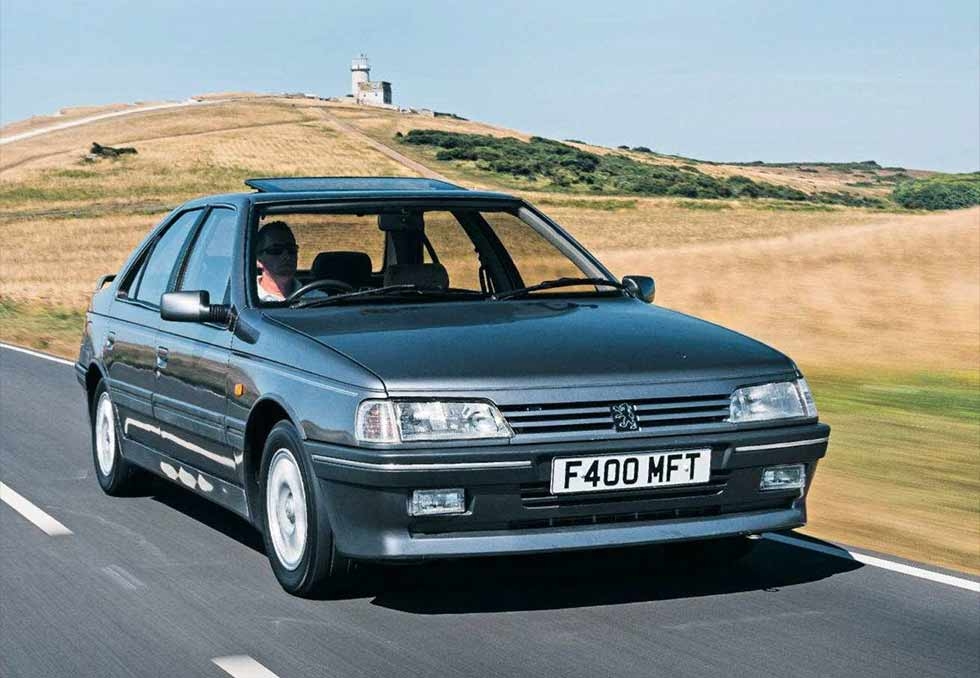
We drive one of a handful of 405Mi 16s left and tell you why you’ll miss them. This hens-teeth Peugeot 405Mi 16 reveals why it was one of the era’s greatest Q-cars, even if it’s overshadowed by its GTI brother. Words Martin Domoney. Photography Jordan Butters.
THE FINAL COUNTDOW ENDANGERED SPECIES
ONLY 6 LEFT PEUGEOT 405 Mi 16 Should you save this nearly extinct Pug?
Every once in a while, a manufacturer gets it bang-on the money with a car. However, despite its brilliance these gems can get forgotten in the ether of more desirable models and more prestigious badges of the time. This means their values plummet and numbers fall rapidly when they’re only a few years old. The big names like BMW, Ford and Vauxhall had its performance saloons snapped up readily in the late-1980s, but while values depreciated slowly, the more obscure offerings from the French contingent didn’t fair so well on the used car forecourts despite being some of the most engaging and well-honed cars in their class. And so begins the sad tale of the Peugeot 405 Mi 16.
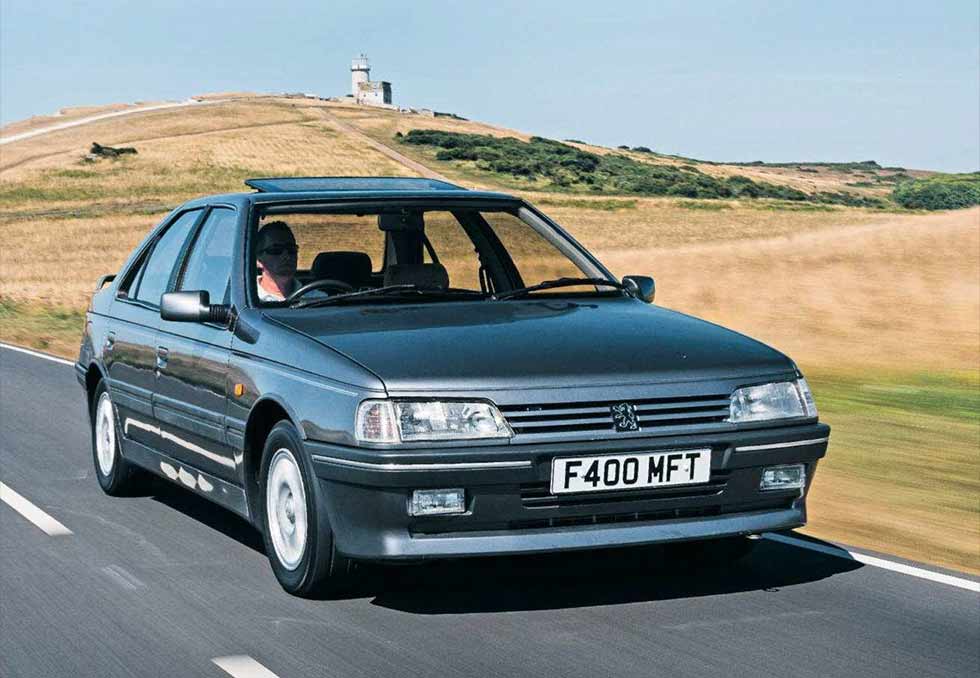
It’s quite hard to say exactly why examples of this model became so thin on the ground so quickly. They were designed to have as few mud traps as possible, which meant they didn’t really rust bar the front cross-member and sills if they suffered stone-chips. Of course, French cars have never been known for having the highest quality electrics, so are these to blame? Possibly, but the truth is the most likely reason for the Mi 16’s demise is actually not down to the car itself.
We all know the 405’s little brother. Mutter ‘hot hatch’ and there’ll be a queue of misty-eyed petrol-heads ready to wax lyrical about the 205 GTI. To an extent, rightly so. But one of the main reasons taxed-and-tested 405 Mi 16s only survive in single figures is that many 205 owners decided the saloon’s superior 16v engine would be better in their pocket rockets, and 405s were snapped up cheap as donors. Even now the forums are full of questions of how to get the motor’s exhaust manifold to clear the GTI’s bulkhead. This is a great shame and also quite a feat, given the Mi 16’s healthy production run from 1987-1992. In fairness, it’s unanimous that the 405’s all-aluminium 2.0-litre is an absolute peach. If you’re more partial to a crisp, hard-revving twin cam than anything forced-inducted, then the all-aluminium XU9J4 has to be on your bucket list of motors to experience. But, this doesn’t mean it’s better off anywhere other than in the car it was fitted to in the first place. As a package, the 405 Mi 16 is sublime – mixing big-saloon practicality with giggle inducing handling and looks that don’t scare old ladies, but will get you nods of approval from those who know.
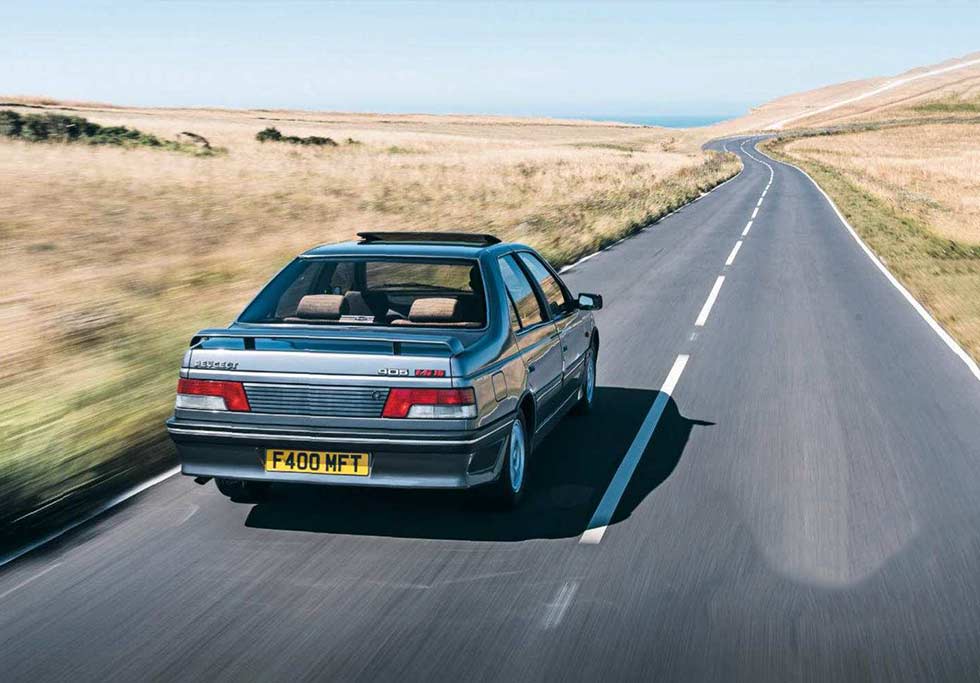
It’s a pretty accurate assumption to make that a lot of flashier motors got shown up by Mi 16s back when they were new. The owner of this fine example tells me it’s something he still takes great joy in today, because – to use the tired cliché – it’s a right wolf in sheep’s clothing.
Shaped and styled by the fair hand of Pininfarina, the 405 manages to make a traditional ‘three-box’ saloon shape elegant. It’s a fine car to behold, and that’s before taking into account the cheeky extras that the Mi 16 included–deeper front and rear bumpers with the former sporting two rectangular foglamps, deep side cladding, a raised bootlid spoiler and racy five-spoke alloy rims. All these cues come together to forma purposeful, sharp look, without being in anyway crass or obvious. They merely make you question what might lie beneath the skin of such an otherwise common-or-garden car, with the only confirmations of the 405’s performance bloodline being the black and scarlet Mi 16 boot badge and subtle pinstriping, ending with a ‘16v’motive on each rear flank.

Popping the door and lowering yourself into the waiting sports recliners, everything seems very civilized and comfortable. More red and black color scheme in here; the door trims and sports seats feature a fine chequered pattern which – as with the rest of the car’s aesthetic–mix flair with a reined-in, grownup feel. A skinny center cubby box sits too low for elbow-restage on long journeys, and scratchy, brittle-feeling plastic makes up much of the trim and switchgear. It’s definitely French.
A large dashboard console sweeps across in front of the driver, housing a clean, logical instrument cluster. There are no lairy white dials here, but an oil temperature gauge is another notable addition. And a rev counter – with a 7k redline?! Curiosity well and truly peaked. The chunky three-spoke steering wheel allows a clear view of the dials, and the gearknob is placed well to hand. Sparking up the engine, revs rise briefly before settling into a hushed but slightly off-beat idle. Getting the 405 rolling is easy; the clutch is surprisingly light and forgiving, and working up through the gears gives no indication of any naughtiness. Steering is power-assisted but gives good feel, and the brakes respond obligingly, if slightly numb on the pedal.
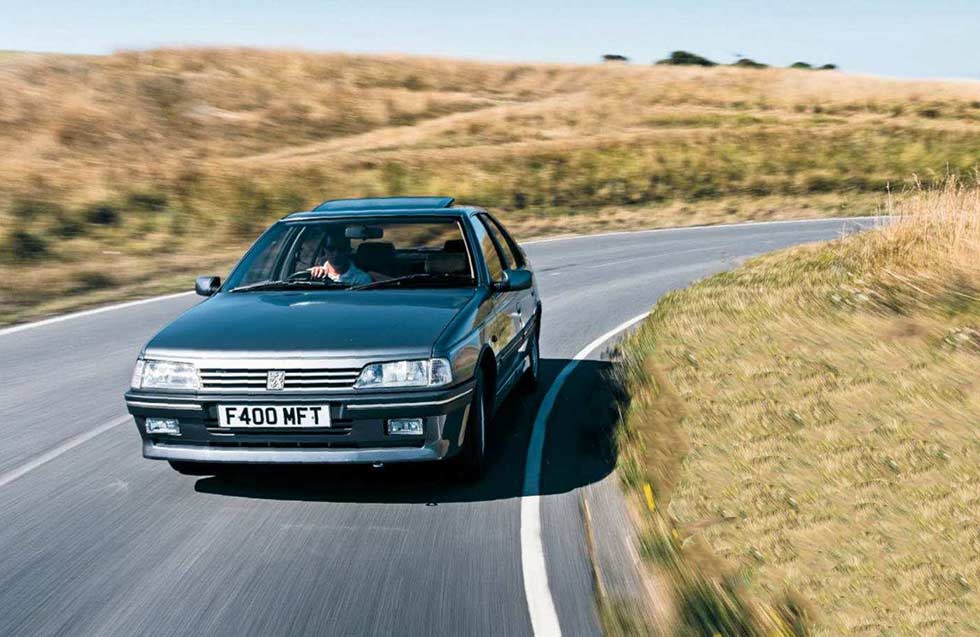
With the Sussex coastline in view and ribbons of fresh tarmac ahead, it doesn’t take much encouragement to get the 1.9’s sixteen valves opening and closing a bit more frantically. Just above 4k is where the XU gets interesting; engine notes change and induction noises become more pronounced as that tacho needle strays temptingly close to the red bit. Rowing up and down the gears quickly becomes second nature, and before you know it, all concentration is on upshifting just before the limiter bounces, then pegging the pedal again as soon as the next cog’s engaged. Sixty mph is easily achievable in second gear, and the shriek of the motorsport derived lump is addictive. Engines don’t sound like this in modern cars. Not visceral, raw, unmistakeably naturally aspirated. The long runners on the Mi 16’s inlet manifold and big-valve head can be thanked for its top-end eagerness. It rushes to the red line, then gets there and instantly begs for more.
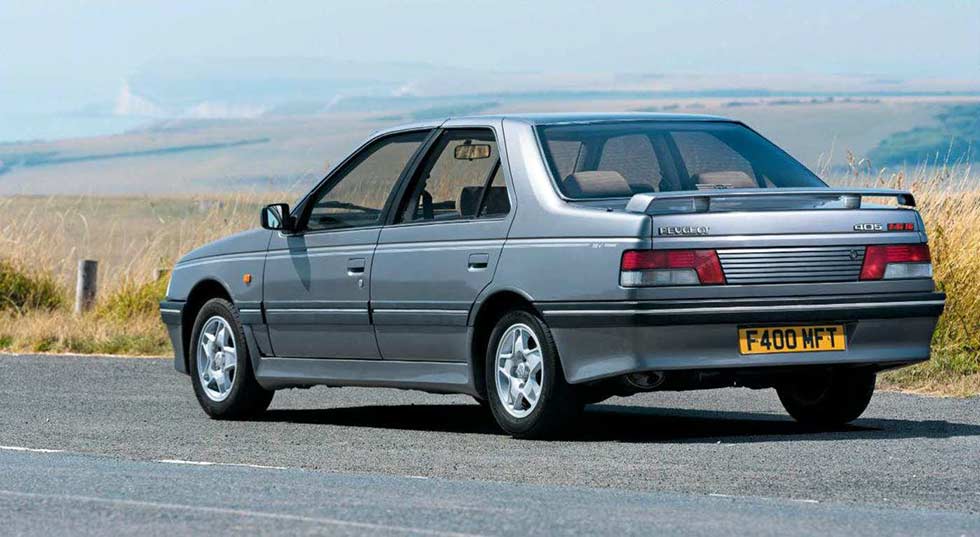
Even on this early car’s 14-inch wheels, there’s very little sidewall roll into corners. The 405 is all-independent, and the suspension does a superb job of flattening out imperfections while also keeping the body flat; threading a car as large as the 405 through tight bends and switchbacks shouldn’t be anywhere near as easy as it is.
A big contributing factor to this is the stiffness of the shell – high door sills and a shallow bootlid help keep the body rigid, allowing the front struts and rear torsion bars to do their work. What’s also immediately apparent is how delightfully light the 405 feels. The car tips the scales at 1108kg, which isn’t much at all for a spacious 5-seater ‘loon with a half-decent boot. You’re aware that you’re piloting a big car of course, it just fools the mind because it doesn’t behave like one at all.
Once used to the slightly dead feel of the brake pedal, the Mi 16 can be set up for corners a treat. Downshift into the power band, quick brake dab, pitch it in, marvel at the lack of understeer, forget you’re driving a family saloon, pin the throttle and ride out of the bend in a fury of tyre chirrup and screaming twin-cam. Then inconspicuously pick the kids up from school and do the weekly shop.
‘IT’S UNANIMOUS THAT THE 405’S ALLALUMINIUM 1.9 IS AN ABSOLUTE PEACH’
The Drive-My Modern Classics view
As fast, range-topping saloons go, the Mi 16 is up therewith the best of them. Having one on your driveway now is bound to invite more questions than admiring stares from onlookers, but once you get to understand the car properly, it’s hard to ignore how right Peugeot got it. The star of the show is without doubt that engine; but the rest of the car works so well around it.
Buying one of these rarities now is not only going to cost a pretty penny, it’s going to be bloody difficult as well. They don’t come up often and when they do, Peugeot buffs tend to snap them up quick sharp without too much haggling. Projects have come up recently for around £1500, but a well-sorted 1.9-litre car with its original wheels and history will set you back between four and six grand.
While this may come as a disappointment to many who want the e to own a 405 Mi 16, it’s still a bargain compared to the more common and borderline extortionate 205 GTI. Moreover, it’s reassuring to know that any of these near-extinct lions that do change hands now will almost certainly be saved, repaired and enjoyed, rather than butchered for their hearts – which can only be good thing.
TECHNICAL DATA FILE SPECIFICATIONS PEUGEOT 405 MI 16
Engine 1905cc, 4-cyl, DOHC
Transmission 5-speed manual
Max Power 155bhp @ 6500rpm / DIN nett (metric)
Max Torque 131lb-ft @ 5000rpm DIN nett (metric)
Weight (dry) 1108kg
PERFORMANCE
0-62mph 8.6 seconds
Top speed 137mph
Economy 31mpg
‘DOWNSHIFT INTO THE POWER BAND, PITCH IT IN, MARVEL AT THE LACK OF UNDERSTEER’

‘IT RUSHES TO THE RED LINE, GETS THERE AND BEGS FOR MORE’
LION’S ROAR WHY THE Mi 16 ENGINE IS SUCH A GEM
The 405 Mi 16’s powerplant first debuted in the Citroën BX19 GTI 16v, having already proved itself in motorsport (including the Paris-Dakar rally) and it quickly gained enthusiastic drivers’ love and respect. With an aluminium block and head, it was very lightweight, which gave the 405 Mi 16 a keen turn-in and poise through corners. Coded the XU9J4, the hot four-cylinder’s 155bhp and 131lb-ft of torque punched in at 6500rpm and 5000rpm respectively, which meant it begged to be revved to keep the 405’s speedo needle flying. This top-end heavy power band added to the car’s spirit, and it’s easy to understand why so many were pilfered for the 205 GTI.
Benefitting from a thorough re-work, the Mi 16’s 16v engine features a stronger block than its 8v cousin, as well as lightened and balanced rotating assembly with under-piston oil jets and a performance flywheel, contributing to the engine’s quick-revving nature. The uprated block was topped with an impressively high flowing cylinder head housing twin camshafts, which are hidden beneath a smart, motor sport inspired magnesium valve cover.
I BOUGHT ONE LIAM KELLY
‘My whole family are Peugeot mad–most of them work for the company. When I was a kid, by dad bought home a brochure for the 405Mi 16, and that’s when I knew I had to have one. This one had been languishing in a field for 13 years; I paid £200 for it and it’s only needed minor work to get it back to road worthy. Mi 16 parts (and 405 bits in general) can be hard to come by, so whenever I see any for sale at a reasonable price I snap them up. My garage is full of them!’
THE FINER POINTS
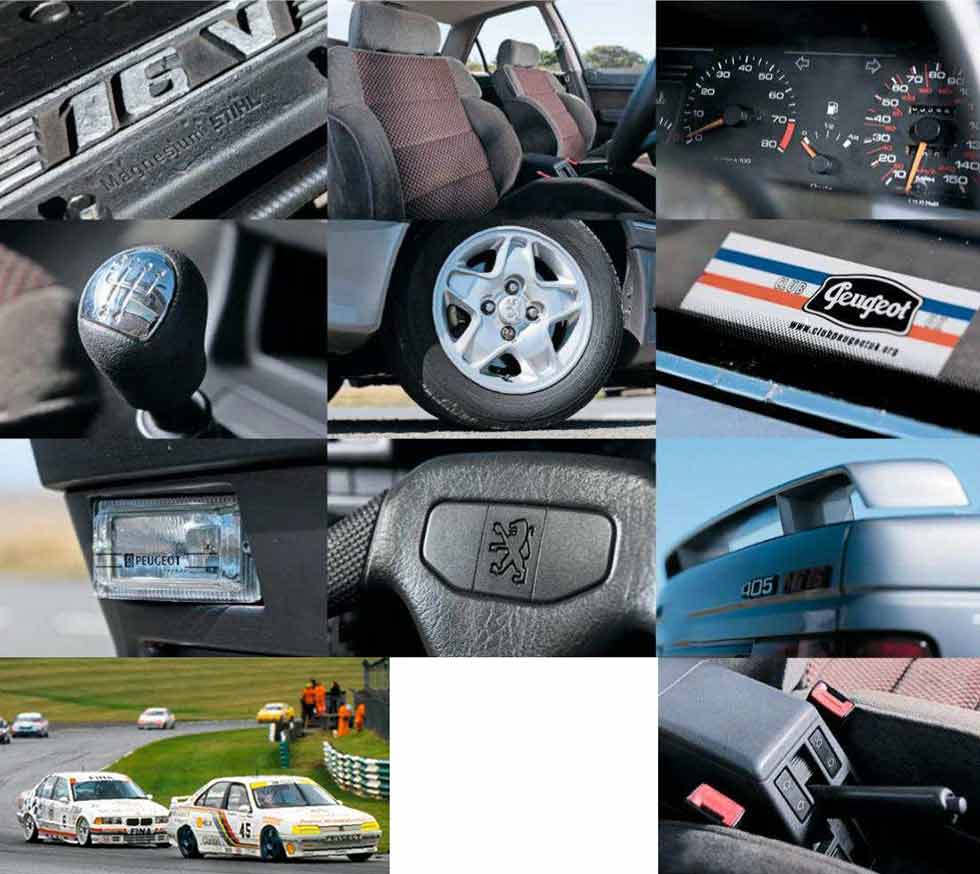
1 Four-pot, 1.9-litre all-aluminium engine thrive son revs and proved its worth in motorsport.
2 Even sports seats are restrained in red and black check.
3 Left dial provides the giggles. Needle on right dial warns of licence in danger.
4 Five-speed manual gets plenty of use. We’re not sure that knob is stock though.
5 Early Mi 16s feature 14-inch alloys but sidewall roll is minimal.
6 The last remaining Mi 16s are all known to the Club.
7 Low key brand sticker adorns front fog lamp.
8 Power assisted steering still provides good feel. Handling is a joy to experience.
9 Subtle performance cues: Boot spoiler and red Mi 16 badge!
10 Central cubby box sits too low to rest elbows on.
‘405s WERE OFF THE PACE AND SUFFERED RELIABILITY ISSUES’
I RACED ONE ROBB GRAVETT
Through 1992 Robb Gravett piloted the Peugeot 405Mi 16 in the BTCC, and in the Touring Car World Cup. It wasn’t smooth sailing, though…
Drive-My: How did you start out driving for Peugeot?
Robb: I came out of the Ford Sierra Sapphire that I’d been driving for Trakstar Motorsport in 1991, and joined Peugeot Talbot Sport. They’d only been running rally cars up until then, so it was a bit of a gamble going into BTCC.
Drive-My: What were your first impressions of the car?
Robb: The 405s were off the pace and suffered from reliability issues. They’d get stripped down and rebuilt between races but the crew had real problems getting them back together again consistently, so they were a struggle to drive competitively. The Peugeot UK team ran different cars to the French teams, who were far more successful at the time. It proved the car could be made to work well, it just needed a lot of development, and preparation to improve it.
Drive-My: Sounds like the drivers were up against it then! How did the team respond?
Robb: They experimented with different setups. The trailing arms were flexing under the load of the slicks and causing the car to rear steer. Their answer was to develop a rear beam; I objected as it flexed, but they stuck with it as so much money had been spent. The beam broke during testing and one of the rear wheels went into the arch!
Drive-My: Did the car gain racing success?
Robb: To an extent. Peugeot’s marketing director, the late Brian Llewelyn, asked me to drive the Mi 16 at the 1993 Touring Car World Cup at Monza after I had been selected to represent the UK and had been given control of setting it up. I’d dropped the ride height by 40mm,whichmeant re-working the geometry. Doing this meant it outpaced the European 405s, but it was too little too late for the overall standings. Two months later the car led Class 2 in the Wellington 500 in NZ for over half of the race, but unfortunately a broken driveshaft forced us out. To me, the car had potential, it’s just a shame the team lacked expertise early on.





